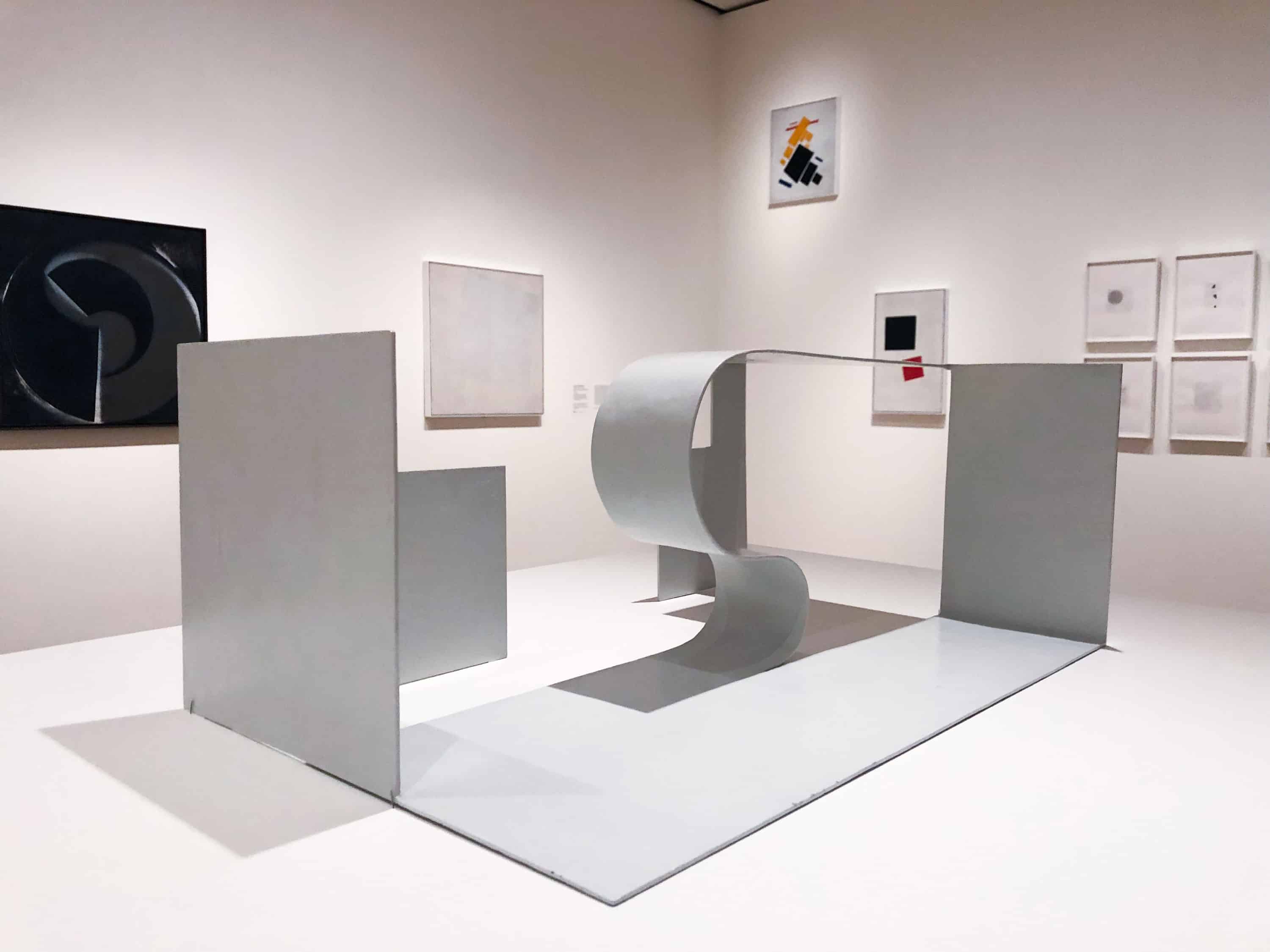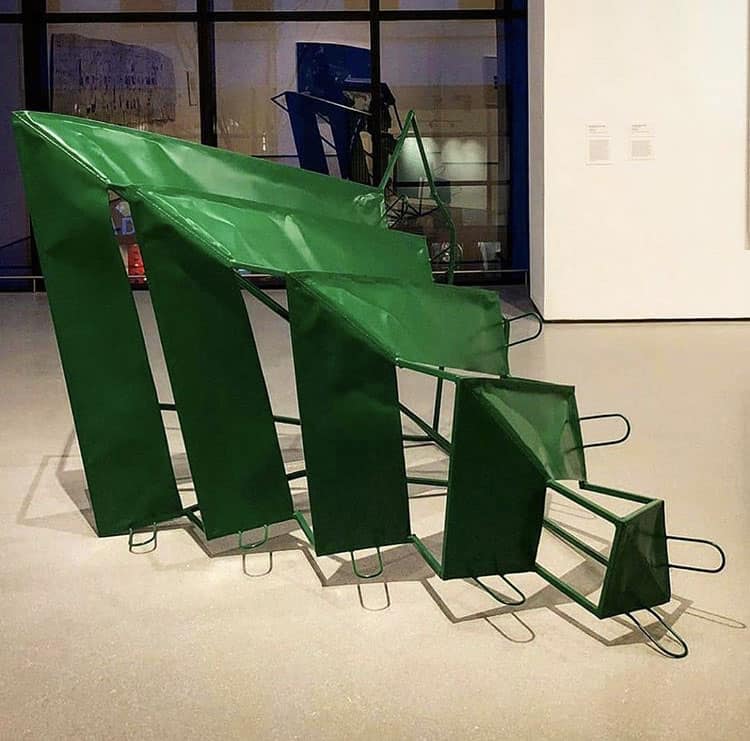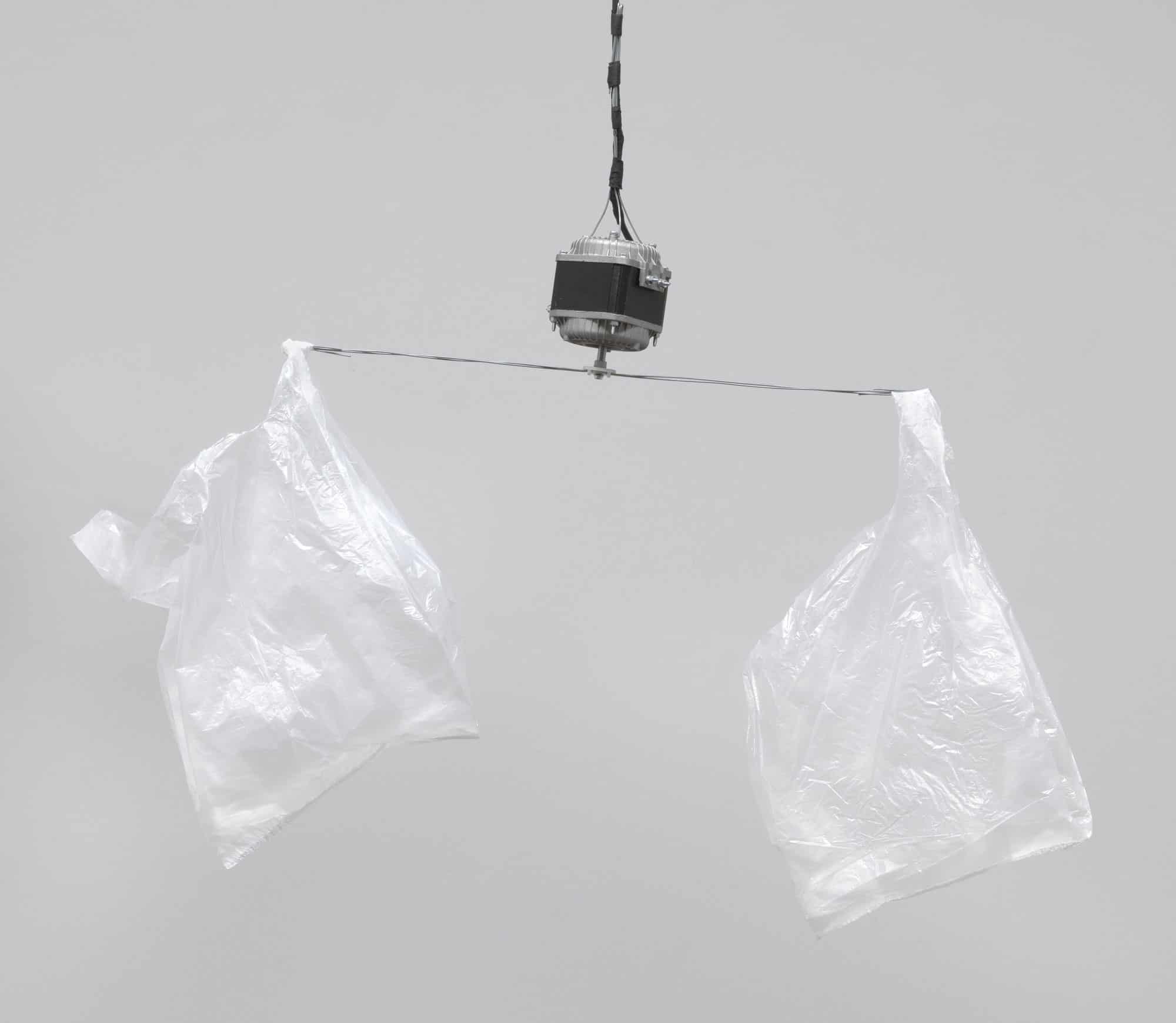The Museum of Modern Art in New York reopened to the public in late October 2019. On the very first day, lines of enthusiastic visitors stretched for miles along the neighbouring streets. You had to pay your dues to be granted access to this art sanctuary. It certainly wasn’t easy. The crowd stuck together even across the threshold. To glance at the new iteration of the museum’s art collection, you had to follow the tight-knit hordes of people, frequently only sneaking a peak at the display over someone else’s shoulder. Upon conceding that a proper visit involves more than a single walk through, we decided to focus on discovering certain stories. This particular story traces the presence of the Polish artists whose works are featured on the current exhibit of the museum’s collection.

The Museum of Modern Art (MoMA), New York
Katarzyna Kobro – white yet pronounced, abstract and geometric planes situated perpendicularly in relation to one another, on the one hand, shape the space which they’re defining; on the other hand, they open the object up to its surroundings.
On the loan from the Muzeum Sztuki in Łódź, this artwork’s presence at MoMA is far from random. In 1976, the exhibition “Constructivism in Poland 1923-1936” opened in New York (30 January-31 March). For the first time in history, constructivists presented their work in the United States. Kynaston McShine, the show’s curator, unveiled the selection of over fifty pieces (sculptures, paintings, graphics and photographs) by a group of five artists, including Henryk Stażewski, Karol Hiller and Henryk Berlewi. However, the majority of artworks on display was created by Katarzyna Kobro, and Władysław Strzemiński. Over twelve objects by Kobro, made from a variety of materials – metal, wood, plastic and glass – were showcased on the exhibit, including the piece at hand entitled “Spatial Composition 5” (1929). This object can be reduced neither to the miniature architecture, nor furniture design despite some initial dismissive claims of Kobro’s contemporaries. Radically unistic surfaces and shapes limited to the bare minimum determine and define the space. In her essay published in the magazine “Europa” (no.2), Kobro stated the following: “[…] sculpture is a part of the space in which it is located. […] Sculpture enters space and space enters the sculpture. The spatiality of its construction, the connection between sculpture and space, force sculpture to reveal the sincere truth of its existence. That is why there should be no random shapes in sculpture. There should be only those shapes that position it towards space by connecting with it. The mass is a lie when faced with the sculpture’s essence. […].” According to Kobro, sculpture is part of a space. As the point of condensed tensions, it attains unity with this space owing to the harmony of rhythms. The object displayed at MoMA is a perfect embodiment of this assertion.

Katarzyna Kobro
Edward Krasiński – blue tape as the trademark of a legendary neo avant-garde artist
It was however merely the point of departure. Blue scotch tape placed horizontally at the height of 130 cm incorporated and was attached to anything and everything that sparked the artist’s interest. Similarly to the forms of abovementioned objects by Kobro, Krasiński framed the space he found himself in, marking the walls, doors, protrusions and alcoves. The strip unified works of art, reproductions and everyday objects. It was a sort of conceptual incorporation of reality into the artist’s own world, in other words a symbolic post-duchampian gesture of elevating ordinary things into works of art.
The exhibition at the New York-based MoMA features only a fragment of “the series” comprising nine works in total which were all placed in the museum’s collection. I use the term “series” since the blue scotch tape leads us from the private to the public space, maps out the route back home from the outside. This route’s signposts include the map of the city of Warsaw, number of a tram you took on your way back, plastered façade of a building viewed from the street, patterned wallpaper in an apartment, phone on a shelf and bathroom tiles. The artist leads us into the space of his own – his home and studio. This simple gesture established a connection between the inside and the outside accompanied by a vast array of seemingly clichéd symbols. As Krasiński himself once declared: “What I do is deeply real, to the point it makes you nauseous!”

Edward Krasiński
Zofia Kulik – power, totalitarian systems, authoritarianism, patriarchy
“The Splendor of Myself II” (1997) challenges these social and political tendencies in a slightly jocular manner. The composition of Kulik’s work alludes to Tudor-era images of Queen Elizabeth I, a monarch who decided to renounce her “feminine” side to corroborate and solidify her independence, respect of the people and “manly” decision-making. The queen – pure virgin. For centuries, government and church have been inextricably linked. Queen Kulik experienced the totalitarian regime, communism and Soviet rule for most of her life. She wields aptly altered symbols of her reign – a cucumber and blossoming dandelion (a weed-like flower ubiquitous at squares, lawns and parks all around Poland, the artist’s country of origin). All it takes is a light blow of air for a flower to disappear and leave nothing behind except for a bare stem. A spot-on reference to the system that was blown to pieces by the powerful nation-wide social protests in 1989. For the power belongs to the people – they are the ones that build and legitimize nations, profess their endorsement either by taking sides or (oh, the irony!) eschewing “engagement”. Queen Kulik composed her portrait from dozens of photographs depicting a male figure (which is in fact that of Zbigniew Libera – an esteemed critical artist defying patterns of behavior, gender roles, cultural notions about the body and memory). The queen-mother, a vessel for all of her “children”/worldviews, criticizes and challenges male-centric systems resting upon clout, patriarchy, cross and sickle.

Zofia Kulik
Ewa Partum as a pioneer of the conceptual and feminist art
The work “Autobiography” (“Autobiografia”, 1971-1974) acquired by MoMA makes no statement regarding feminism or the struggle for female representation in the artistic and cultural canon. Partum’s own unique language was just emerging as she started working on this piece in 1971. It’s a literal autobiography of a young artist shaped and born out of all the things deemed widely iconic – at the time when male writers, philosophers, composers, poets and artists dominated the elites. Rarely does a female name appear amidst the plethora of men. Generations of men compiling encyclopedias and canons consolidate and create the male world spelled out as the artist’s own name and surname. It’s the affirmation of these circumstances rather than their attempted rebuttal. This is the world we live in. This is the world that shapes next generations of people and the artist herself. In 1974, Partum notably erased one name at the bottom of a letter “U” and replaced it with another one – a name of her newborn daughter. Years later, “Autobiography” was incorporated into a performance staged during a private marriage ceremony in Berlin (1985). “My work is not in any case a flirt with patriarchal culture. I understand my actions as initiating a dialogue between two equal partners; as a game between two equal works of art”, Ewa Partum stated in an interview for the Obieg magazine (2014).

Ewa Partum
Monika Sosnowska – point of departure for Sosnowska’s sculptures are objects of the so-called small architecture situated in the public space (a staircase, metal rails, barriers, building frame etc.), as well as components long consigned to oblivion (carpet-beating stands at the rear of tenement houses or in-between apartment blocks where children used to play)
She annexes the structures that she proceeds to modify and experiment on, ultimately erasing their original function. It’s also the case with the work “Untitled” (2012) that was inspired by the tiered shoe stands located once upon a time at open-air bazaars on the outskirts of the cities in Central and Eastern Europe. Unattended and desolate objects existing only in memories of the people who had lived in the bygone era manifest themselves in the artist’s sculptures as relicts distorted by the imperfect recollection, as oneiric mirage dissolved and crumpled in the dense fog of the unreal, obscurity, and us chasing the future.
It’s worth pointing out that another work by Monika Sosnowska placed in the art collection of MoMA – “Fly Repellent” (for Parkett no.91) – was created in 2012 in collaboration with the Parkett publishing house. It’s fascinating how this delicate rustling piece set in motion – essentially a multiple revolving on its axis – seems like an incredibly ephemeral work of art that reveals a completely different side to Sosnowska as an artist, who has compiled an otherwise monumental and robust oeuvre.
Monika Sosnowska
Monika Sosnowska













